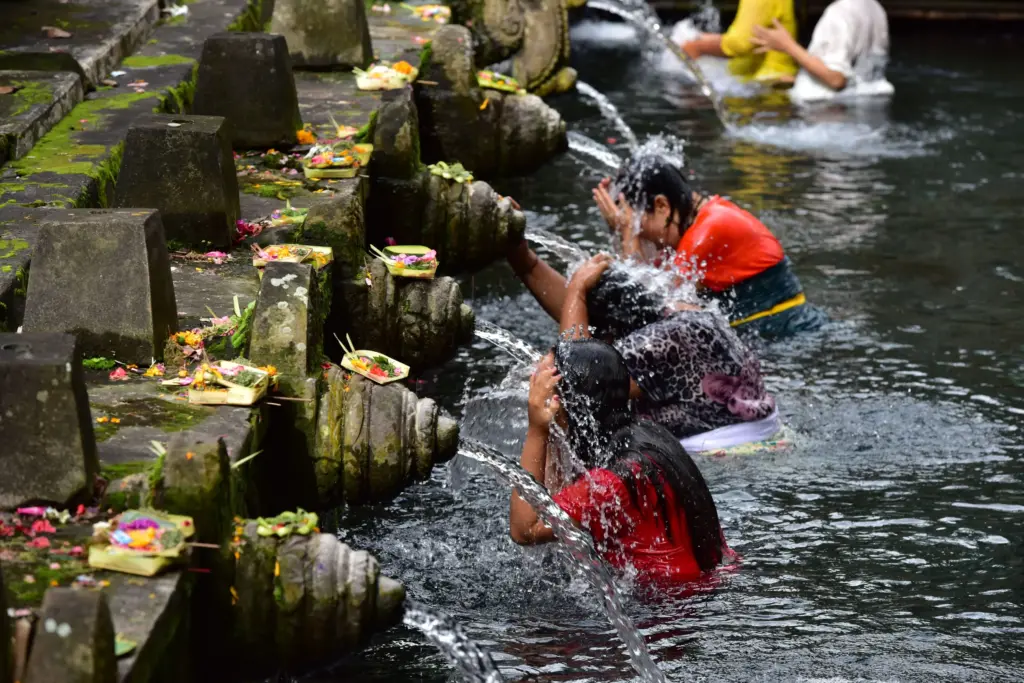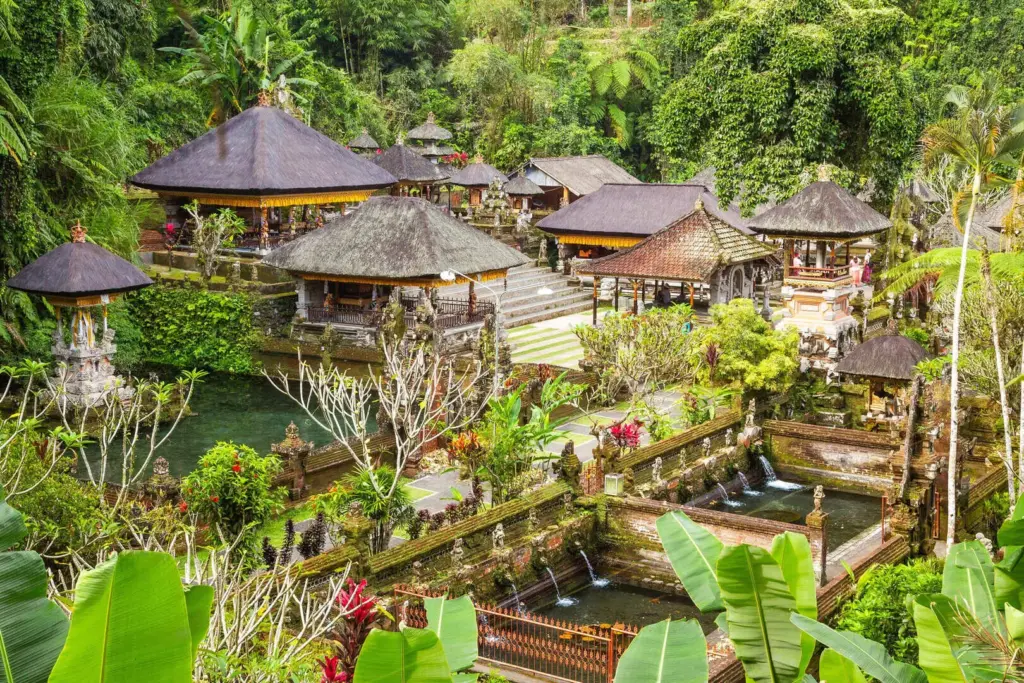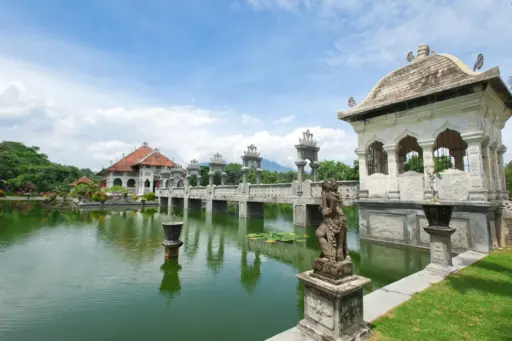Ancient water temple in central Bali offering sacred cleansing rituals, cultural insight, and serene spirituality.
Tirta Empul Water Temple is one of Bali’s most sacred and visually captivating cultural sites. Located near the village of Manukaya in central Bali, not far from the town of Tampaksiring, this centuries-old temple is known for its natural spring, which feeds a series of purification pools used by Balinese Hindus for ritual cleansing. It is a place where religion, tradition and the natural world all converge – and where visitors, both local and foreign, come not just to observe, but often to participate in something deeply spiritual.
The temple’s history dates back to around 962 AD, during the Warmadewa dynasty. It was built around a natural spring believed by the Balinese to have been created by the god Indra. According to local legend, the spring emerged after Indra pierced the earth with his staff to create holy water and revive his poisoned troops. This mythology is not just a story – it forms the foundation of the temple’s spiritual significance. The name “Tirta Empul” means “holy water spring,” and for more than a thousand years, Balinese people have come here to bathe in its waters as part of a purification ritual known as melukat. It remains a functioning temple, active with daily offerings, ceremonies and local worshippers who treat it as more than just a historical monument.
Sacred Water and Ritual Purification
Tirta Empul is culturally important because it represents the role of water in Balinese Hinduism. Water is not just a physical necessity; it is considered sacred and central to the concept of taksu, or divine energy. The temple’s spring is believed to be charged with spiritual power, capable of cleansing the body and mind of negative energy, bad karma, and illness.

Each spout in the bathing area carries a unique purpose, and locals follow a specific sequence when performing the ritual, moving from one spout to the next while praying and submerging themselves. Some spouts are intended for general purification, while others are used specifically to cleanse the spirit, restore emotional balance or even protect against black magic. Two spouts are traditionally skipped, as they are used only in cremation rituals.
Architecture and Atmosphere
The temple is also a beautiful example of Balinese architecture and design. Entering the temple complex, you pass through a series of gates leading into different courtyards. The inner sanctum is where the spring emerges, bubbling up into a clear pool filled with koi and shaded by old trees. Water from the spring is channelled into a large rectangular bathing pool divided by low stone walls, where rows of sculpted spouts line the edges. You will see worshippers dressed in temple attire – men in sarongs and udengs (traditional head wraps), women with sashes tied around their waists – waiting their turn in the water, often with a flower tucked behind the ear or a small offering in hand.
Visiting Tirta Empul as a Guest
Foreign visitors are welcome at Tirta Empul and are even encouraged to participate in the purification ritual, provided it is done with respect. Modest clothing is required to enter the temple, and sarongs and sashes are available for rent or included in the ticket price. If you plan to enter the water, you must wear a special water sarong over your clothes and remove shoes before entering the pool area. It is important to remain quiet and respectful in the bathing area, as this is not just a tourist attraction but an active place of worship.
Tirta Empul is located in Gianyar Regency, about 30 to 40 minutes north of Ubud. The drive passes through villages, rice fields and scenic valleys, making it an easy half-day trip from most parts of central Bali. If you are staying in Ubud, you can reach the temple by scooter, taxi or as part of a guided tour. Many day tours also include nearby attractions such as the Gunung Kawi rock temple, the Presidential Palace of Tampaksiring and coffee plantations offering tastings of Bali’s famous kopi luwak. The road to the temple is well-marked and paved, with parking available near the entrance. There are also several warungs and small shops nearby selling drinks, snacks and souvenirs.
Upon arrival, visitors must pay a small entrance fee, usually around IDR 50,000 for foreigners. The ticket includes access to the entire complex, and in most cases, rental of a sarong and sash. Changing rooms and lockers are available for those planning to enter the water. It is best to bring your own towel and a dry change of clothes if you are participating in the purification ritual, as you will get fully wet. Early morning is a good time to visit to avoid crowds and experience the temple at its most peaceful, though it remains active throughout the day.
Symbolism and Lasting Impression
Beyond its physical beauty and rituals, Tirta Empul carries deep symbolic meaning in Balinese life. It is a place that reflects the close relationship between the spiritual and natural worlds. Balinese Hinduism blends animism, ancestral worship and Hindu cosmology, and water temples like Tirta Empul play a central role in that blend. They are not simply places to pray, but nodes in a vast spiritual network that links temples, volcanoes, rivers, and the ocean in a sacred landscape. The water here is used not only for personal purification but also in temple ceremonies, agricultural rites and the subak system of irrigation that sustains Bali’s rice fields. Everything is interconnected, and the temple sits at the centre of that connection.
Visitors often speak of a sense of calm or clarity after spending time at Tirta Empul. Whether you believe in its spiritual power or simply appreciate its cultural depth, it is hard not to be moved by the quiet reverence of the place. The sound of water, the scent of incense, the soft chant of prayers drifting through the air – it all combines into an experience that feels timeless. You can take photos, you can learn the history, but the real impact comes from simply being present. Watching as people step into the water with intention, bowing their heads under each spout, you begin to understand that this is not about spectacle. It is about connection.
Tirta Empul is more than a temple. It is a living expression of what makes Balinese culture so unique: the balance between people and nature, the respect for tradition, and the everyday presence of the sacred. For travellers, it is a rare chance not just to witness that culture, but to quietly take part in it. Whether you come as a spiritual seeker, a curious observer, or someone just looking to understand Bali a little more deeply, a visit to Tirta Empul offers a moment of stillness in a world that often moves too fast. And that in itself is something sacred.




